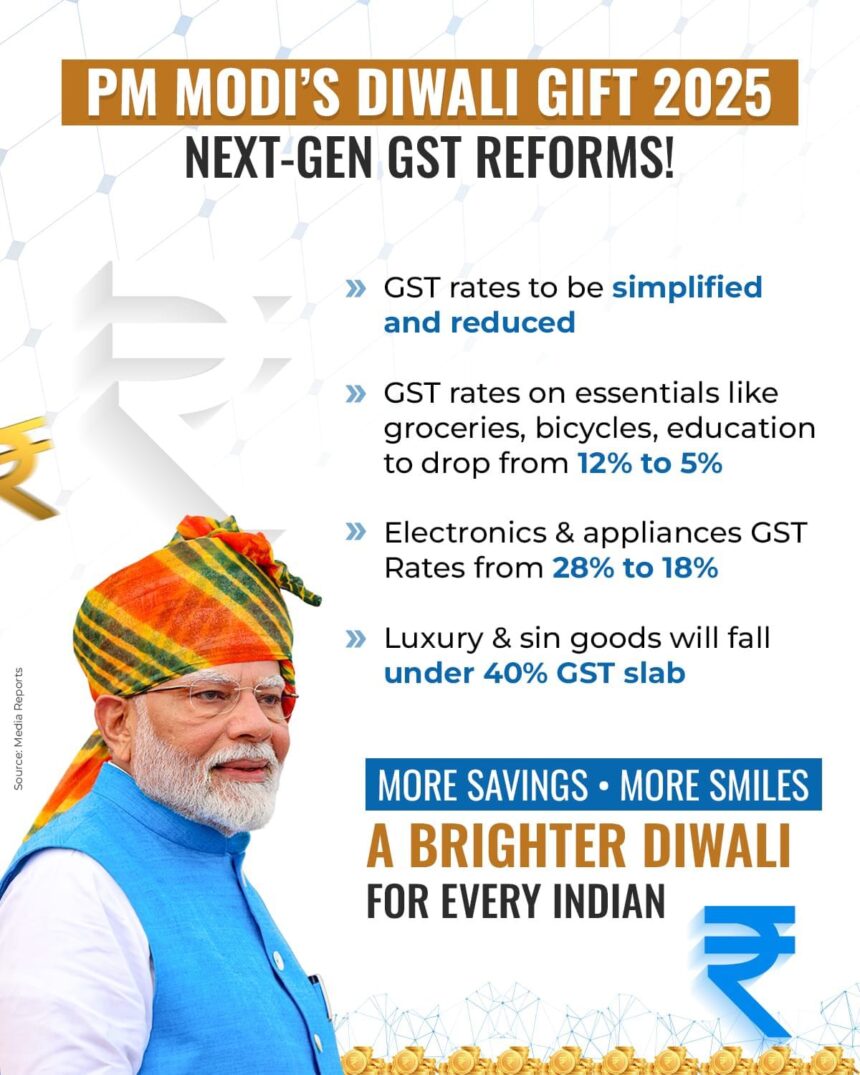PM Modi’s Diwali Gift 2025: Next-Gen GST Reforms
This Diwali 2025, the Indian government has announced a revolutionary move to make GST simpler, fairer, and more beneficial for citizens. The initiative, widely hailed as PM Modi’s Diwali Gift 2025, aims to reduce the tax burden on essentials, electronics, and luxury items while promoting economic growth and consumer-friendly policies.
The Next-Gen GST Reforms are designed to bring more savings, more smiles, and a brighter Diwali for every Indian.
Key Highlights of the GST Reforms
Simplification of GST Rates:
GST slabs have been streamlined to make the taxation system more transparent and easier to understand.
Instead of multiple confusing slabs, there will now be simplified categories for essentials, electronics, and luxury goods.
Reduction in GST Rates on Essentials:
Items like groceries, bicycles, and education materials will see GST drop from 12% to 5%.
This will directly ease household budgets and make everyday necessities more affordable.
Electronics & Appliances Tax Cut:
GST on electronics, including mobile phones, TVs, and appliances, will reduce from 28% to 18%.
This reform encourages digital adoption, home modernization, and affordable tech access for middle-class families.
Luxury & Sin Goods Reclassification:
Luxury items and sin goods such as alcohol, tobacco, and high-end products will fall under a 40% GST slab.
This ensures equitable taxation while encouraging responsible consumption.
Economic Significance of the Diwali Gift
Boost to Consumer Spending:
Reduced GST rates make goods more affordable, encouraging higher consumer spending during the festive season.
This is expected to stimulate economic growth and market activity.
Support for Middle-Class Families:
With GST reduction on essentials and electronics, household budgets will be less strained, improving overall quality of life.
Encouragement for Local Manufacturing:
Lower GST rates on goods can lead to higher demand for locally produced items, promoting Make in India initiatives.
Transparent Taxation System:
Simplified GST slabs reduce confusion and compliance costs for businesses and traders.
This reform enhances transparency and accountability in the taxation system.
Timeline and Implementation
Announcement Date: Ahead of Diwali 2025
Effective Date: Expected from 1st October 2025
Implementation Strategy:
Gradual rollout of reduced rates on essentials and electronics
Awareness campaigns for businesses and consumers about new GST slabs
Digital portals updated to reflect simplified GST structure
FAQs About PM Modi’s Diwali Gift 2025
Q1: Which items will see GST reduction under this reform?
A: Essentials like groceries, bicycles, education materials will drop from 12% to 5%, electronics and appliances from 28% to 18%.
Q2: What about luxury and sin goods?
A: These items will now fall under a 40% GST slab, ensuring fair taxation.
Q3: How will this impact household spending?
A: Reduced GST rates mean lower prices for everyday essentials and gadgets, increasing disposable income.
Q4: Will businesses face challenges implementing these changes?
A: While initial adaptation may be required, digital GST portals and simplified slabs will reduce compliance complexity.
Q5: What is the overall goal of these reforms?
A: To boost consumer confidence, stimulate economic growth, and promote fair taxation across all goods.
Human-Friendly Benefits of the GST Reforms
Savings for Families:
Lower taxes on essentials make daily life more affordable, especially for middle-class households.
Access to Technology:
GST reduction on electronics allows families to buy home appliances and tech products at more reasonable prices.
Support for Education:
Reduced GST on educational materials makes learning resources more accessible to students and parents.
Encouragement for Responsible Spending:
Higher tax on luxury and sin goods promotes mindful consumption.
Simplified Compliance for Businesses:
Traders and companies benefit from less paperwork, lower complexity, and easier tax filing.
Wishing and Celebrating Diwali 2025
The GST reforms are aptly timed for Diwali, the festival of lights, symbolizing prosperity, happiness, and hope. Citizens and businesses alike can celebrate a “brighter Diwali” thanks to:
More disposable income due to lower taxes
Affordable shopping for family, friends, and essentials
Boosted economic activity across industries
Festive greetings can reflect these reforms:
“This Diwali, let’s celebrate savings, prosperity, and a brighter future for every Indian!”
“PM Modi’s Diwali Gift 2025 brings more smiles and more reasons to rejoice!”
Conclusion: A Brighter Diwali for Every Indian
PM Modi’s Next-Gen GST Reforms are more than a financial adjustment—they are a strategic move to empower citizens, simplify taxation, and stimulate the economy.
By reducing GST on essentials, electronics, and education, and rationalizing taxes on luxury and sin goods, these reforms:
Directly benefit families by increasing disposable income
Support businesses through simplified compliance
Encourage responsible consumption and social equity
Promote long-term economic growth and development
The Diwali 2025 GST reforms embody the spirit of “More Savings, More Smiles, A Brighter Diwali”, reflecting a government committed to the welfare of its citizens and a thriving, modern economy.
This initiative ensures that festive joy is not just about celebration, but also about meaningful financial relief and empowerment for every Indian, making it a truly transformative Diwali gift.









Very interesting information!Perfect just what I was searching for!